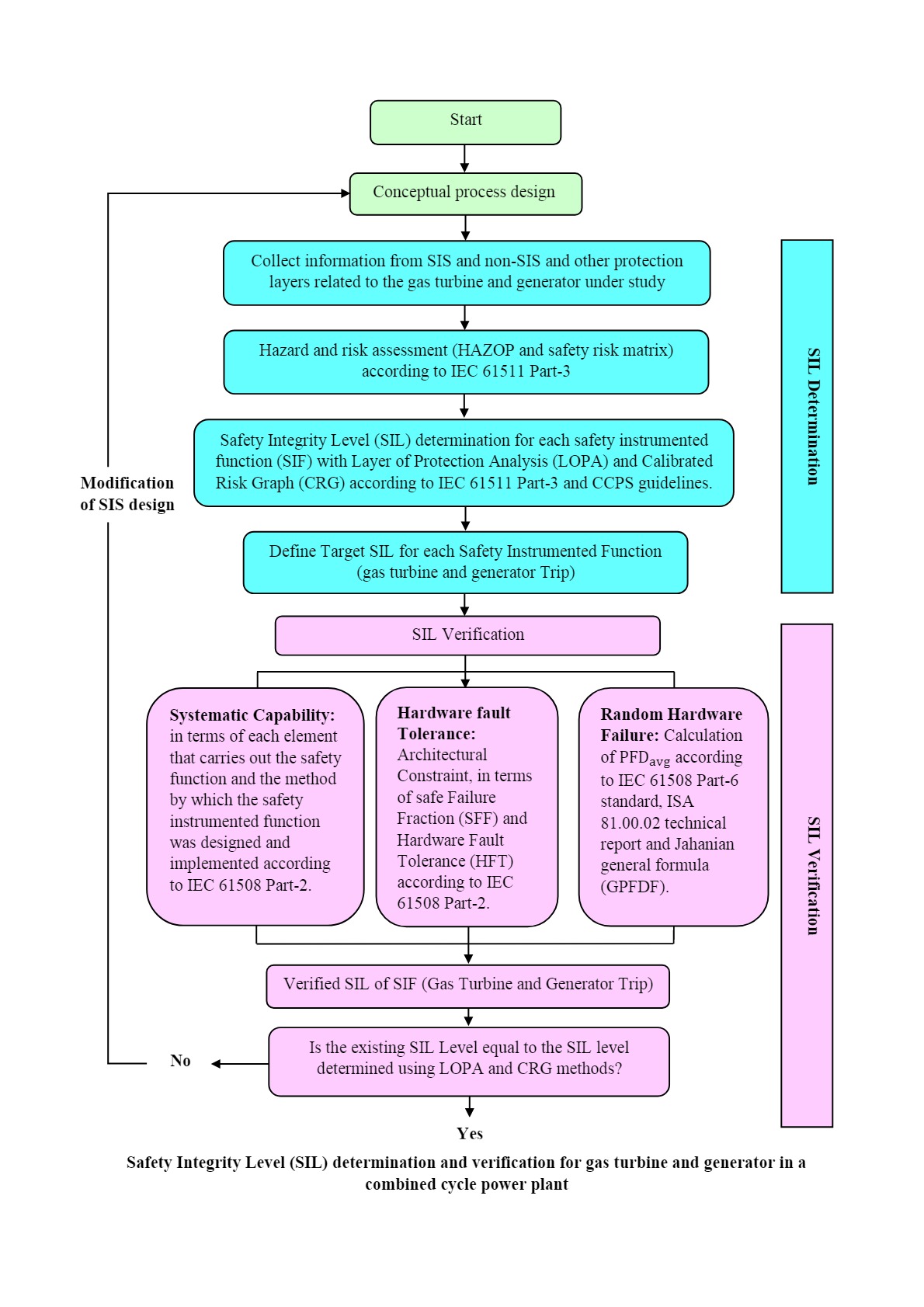Volume 14, Issue 2 (6-2024)
J Health Saf Work 2024, 14(2): 244-271 |
Back to browse issues page
Download citation:
BibTeX | RIS | EndNote | Medlars | ProCite | Reference Manager | RefWorks
Send citation to:



BibTeX | RIS | EndNote | Medlars | ProCite | Reference Manager | RefWorks
Send citation to:
Gholami B, Jabbari M, Eskandari D. Safety Integrity Level (SIL) Determination and Verification for Gas Turbine and Generator in a Combined Cycle Power Plant. J Health Saf Work 2024; 14 (2) :244-271
URL: http://jhsw.tums.ac.ir/article-1-6981-en.html
URL: http://jhsw.tums.ac.ir/article-1-6981-en.html
1- Department of Occupational Health and Safety Engineering, School of Public Health and Safety, Shahid Beheshti University of Medical Sciences, Tehran, Iran
2- Department of Occupational Health and Safety Engineering, School of Public Health and Safety, Shahid Beheshti University of Medical Sciences, Tehran, Iran | Workplace Health Promotion Research Center, Shahid Beheshti University of Medical Sciences, Tehran, Iran
3- Department of Occupational Health and Safety Engineering, School of Public Health, Shahrekord University of Medical Sciences, ChaharMahal and Bakhtiari, Iran
2- Department of Occupational Health and Safety Engineering, School of Public Health and Safety, Shahid Beheshti University of Medical Sciences, Tehran, Iran | Workplace Health Promotion Research Center, Shahid Beheshti University of Medical Sciences, Tehran, Iran
3- Department of Occupational Health and Safety Engineering, School of Public Health, Shahrekord University of Medical Sciences, ChaharMahal and Bakhtiari, Iran
Abstract: (866 Views)
Introduction: One of the ways to produce electricity in power plants is to use gas turbines and generators. Due to the use of methane gas as the fuel of the burners and the high rotation speed, this equipment has a high DOW index level, therefore, if the hazardous conditions in the gas turbine are not controlled by the safety instrumented system and the process is not directed to a safe state, Catastrophic events will occur such as fire and explosion and damage to property and people as well as interruption of the power generation process will happen in the long term, so gas turbine safety instrumentation systems can be considered as “critical safety systems”. Therefore, the reliability and availability of their function should be evaluated. The purpose of this research is to determine and verify the safety integrity level (SIL) related to the safety instrumented function (SIF) of the gas turbine and generator in a combined cycle power plant.
Material and Methods: In this study, the safety integrity level was determined by using two methods, Calibrated Risk Graph (CRG) and Independent Protection Layer Analysis (LOPA), and to verify the safety integrity level, the requirements related to random hardware failure, hardware failure tolerance, and systematic capability are considered according to IEC 61511 and IEC 61508 standards.
Results: The results of a case study in gas turbine and generator showed that the LOPA method is more quantitative than CRG and provides more details of independent protective layers, so it is a more suitable method for determining SIL. The SIL verification results show the SIL2 level, closer to the LOPA results.
Conclusion: The obtained results show that the function of the studied gas turbine safety instrumentation system has a suitable level of reliability and availability and is well responsive to risky conditions and possible deviations. The present approach helps safety engineers and instrumentation engineers to calculate the reliability and availability of the Function of the safety instrumentation systems of their process equipment and ensure its acceptability or not.
Material and Methods: In this study, the safety integrity level was determined by using two methods, Calibrated Risk Graph (CRG) and Independent Protection Layer Analysis (LOPA), and to verify the safety integrity level, the requirements related to random hardware failure, hardware failure tolerance, and systematic capability are considered according to IEC 61511 and IEC 61508 standards.
Results: The results of a case study in gas turbine and generator showed that the LOPA method is more quantitative than CRG and provides more details of independent protective layers, so it is a more suitable method for determining SIL. The SIL verification results show the SIL2 level, closer to the LOPA results.
Conclusion: The obtained results show that the function of the studied gas turbine safety instrumentation system has a suitable level of reliability and availability and is well responsive to risky conditions and possible deviations. The present approach helps safety engineers and instrumentation engineers to calculate the reliability and availability of the Function of the safety instrumentation systems of their process equipment and ensure its acceptability or not.
Keywords: Safety Instrumented Level (SIL), Layer of Protection Analysis (LOPA), Calibrated Risk Graph (CRG), Probability Failure on Demand (PFD), Hardware Fault Tolerance (HFT), Systematic Capability (SC)
Type of Study: Research |
Received: 2024/07/2 | Accepted: 2024/06/30 | Published: 2024/06/30
Received: 2024/07/2 | Accepted: 2024/06/30 | Published: 2024/06/30
| Rights and permissions | |
 |
This work is licensed under a Creative Commons Attribution-NonCommercial 4.0 International License. |







